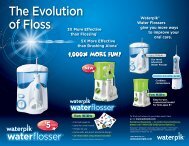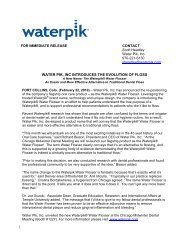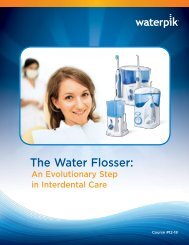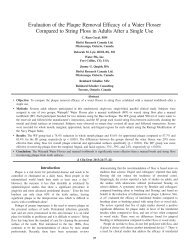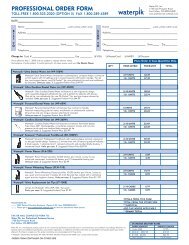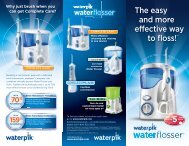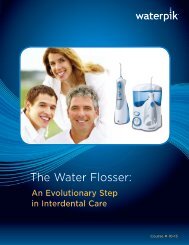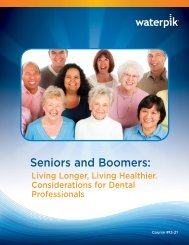Addition of Water Flosser to Power Tooth Brushing: Effect ... - Waterpik
Addition of Water Flosser to Power Tooth Brushing: Effect ... - Waterpik
Addition of Water Flosser to Power Tooth Brushing: Effect ... - Waterpik
You also want an ePaper? Increase the reach of your titles
YUMPU automatically turns print PDFs into web optimized ePapers that Google loves.
62 The Journal <strong>of</strong> Clinical Dentistry Vol. XXIII, No. 2<br />
agent under pressure. This provides two areas <strong>of</strong> hydrokinetic<br />
activity; the impact zone where the solution hits the <strong>to</strong>oth surface<br />
and mechanically removes plaque, and the flushing zone where<br />
the solution is deflected and penetrates the interdental and subgingival<br />
areas. 19-21 The combination <strong>of</strong> a power or manual <strong>to</strong>othbrush<br />
plus a water flosser has been shown <strong>to</strong> be more effective<br />
than manual brushing and flossing for reducing bleeding, gingivitis,<br />
and plaque, providing an alternative <strong>to</strong> string floss. 16-18<br />
The WFS group showed significantly more effective results<br />
for all parameters; importantly, the differences were substantial<br />
compared <strong>to</strong> the SF group, especially for bleeding and gingivitis.<br />
The differences in favor <strong>of</strong> the WFS ranged from 66–73% for<br />
BOP and 45–50% for MGI at W4 compared <strong>to</strong> SF. The differences<br />
between the WFS and the SPP groups were also significant,<br />
but the differences were lower compared <strong>to</strong> the SF differences.<br />
The brushes used in the WFS and the SPP groups were the<br />
same and the SF is from a different manufacturer. It is important<br />
<strong>to</strong> note that each brush had a two-minute timer and 30-second interval<br />
indica<strong>to</strong>rs which help patients brush for the recommended<br />
time. The water flosser group spent about one minute more each<br />
day. Studies have shown that subjects like using the water flosser,<br />
find it easy <strong>to</strong> use, and have continued <strong>to</strong> use it after the study<br />
was completed, with 74% still using it one year later. 26-29<br />
The ADA clinical research guidelines for <strong>to</strong>othbrushes require<br />
a 15% reduction in gingivitis from baseline. 30 The guidelines<br />
for home irrigating devices require a 20% difference compared<br />
<strong>to</strong> traditional products for superiority. 31 In this study, the<br />
WFS group was at least 20% better than the other three groups,<br />
with an 18.2% reduction from baseline for gingivitis scores.<br />
The large reduction in bleeding for all four groups is most likely<br />
related <strong>to</strong> the high percentage <strong>of</strong> bleeding at baseline. These reductions<br />
would be clinically visible <strong>to</strong> the clinician.<br />
The secondary objective was <strong>to</strong> compare the different power<br />
<strong>to</strong>othbrushes on the reduction <strong>of</strong> bleeding, gingivitis, and plaque.<br />
The SPP demonstrated significantly better whole mouth reductions<br />
compared <strong>to</strong> the SF; 26% for BOP, 20% for MGI and 29%<br />
for RMNPI. The SPP was also more effective than the SF for lingual<br />
surfaces (31% for BOP, 33% for MGI, and 50% for RMNPI)<br />
at W4.<br />
This study provides a suggested regimen that was found<br />
consistently superior <strong>to</strong> the use <strong>of</strong> a power <strong>to</strong>othbrush only. The<br />
clinical signs <strong>of</strong> inflammation were reduced by the WFS group<br />
from 67–71.3% for gingival bleeding and 17–19.4% for gingivitis<br />
at W4. The combination <strong>of</strong> a water flosser plus power<br />
<strong>to</strong>othbrush added one minute a day <strong>to</strong> daily brushing recommendations.<br />
<strong>Addition</strong>al studies comparing other regimens may<br />
be needed.<br />
Conclusions<br />
The results <strong>of</strong> this study revealed the following:<br />
1. The <strong>Water</strong>pik Complete Care was significantly better than the<br />
<strong>Water</strong>pik Sensonic Pr<strong>of</strong>essional Plus <strong>Tooth</strong>brush, Sonicare<br />
FlexCare, and the Oral-B Indica<strong>to</strong>r <strong>to</strong>othbrush in improving<br />
gingival health. Notably at W4, the <strong>Water</strong>pik Complete Care<br />
group was 66–73% more effective for BOP and 45–50%<br />
more effective for MGI compared <strong>to</strong> Sonicare FlexCare.<br />
2. The <strong>Water</strong>pik Complete Care was significantly better than the<br />
Sonicare FlexCare (52%) and the Oral-B Indica<strong>to</strong>r <strong>to</strong>othbrush<br />
(1.34 times) for reducing plaque at W4.<br />
3. The <strong>Water</strong>pik Sensonic Pr<strong>of</strong>essional Plus was significantly<br />
better than the Sonicare FlexCare at improving gingival<br />
health. Notably, the Sensonic Pr<strong>of</strong>essional Plus <strong>Tooth</strong>brush<br />
group was superior for all whole mouth and lingual measures<br />
(26% and 31% for BOP, respectively; 20% and 33% for<br />
MGI, respectively).<br />
4. The <strong>Water</strong>pik Sensonic Pr<strong>of</strong>essional Plus was significantly<br />
better than the Sonicare FlexCare at reducing plaque; specifically<br />
29% for whole mouth, 50% for lingual, 1.13 times for<br />
approximal, and 1.33 for marginal areas.<br />
5. All products were safe <strong>to</strong> use.<br />
Acknowledgment: The authors would like <strong>to</strong> thank the entire team at BioSci<br />
Research Canada, Ltd. for their pr<strong>of</strong>essionalism and hard work on this study. This<br />
study was supported by a research grant from <strong>Water</strong> Pik, Inc., Fort Collins, Colorado.<br />
For correspondence with the authors <strong>of</strong> this paper, contact<br />
Deborah Lyle—dlyle@waterpik.com.<br />
References<br />
1. Papapanou PN. Periodontal diseases: epidemiology. Ann Periodon<strong>to</strong>l 1996;<br />
1:1-36.<br />
2. Hidalgo-Rivera F. Smoking and periodontal disease. Periodon<strong>to</strong>l 2000 2003;<br />
32:50-8.<br />
3. Kornman KS, Page RC, Tonetti MS. The host response <strong>to</strong> the microbial chal -<br />
lenge in periodontitis: Assembling the players. Periodon<strong>to</strong>l 2000 1997;14:<br />
33-53.<br />
4. Van der Weijden F, Slot DE. Oral hygiene in the prevention <strong>of</strong> periodontal<br />
diseases: the evidence. Periodon<strong>to</strong>l 2000 2011;55:104-23.<br />
5. Berchier CE, Slot DE, Haps S, van der Weijden GA. The efficacy <strong>of</strong> dental<br />
floss in addition <strong>to</strong> a <strong>to</strong>othbrush on plaque and parameter <strong>of</strong> gingival inflammation:<br />
a systematic review. Int J Dent Hyg 2008;6:265-79.<br />
6. Warren PR, Cugini M, Marks P, King DW. Safety, efficacy and acceptability<br />
<strong>of</strong> a new power <strong>to</strong>othbrush: a 3-month comparative clinical investigation. Am<br />
J Dent 2001;14:3-7.<br />
7. Johnson BD, McInnes C. Clinical evaluation <strong>of</strong> the efficacy and safety <strong>of</strong> a<br />
new sonic <strong>to</strong>othbrush. J Periodon<strong>to</strong>l 1994;65:692-7.<br />
8. Saxer UP, Yankell SL. Impact <strong>of</strong> improved <strong>to</strong>othbrushes on dental diseases.<br />
I. Quintessence Int 1997;28:513-25.<br />
9. Saxer UP, Yankell SL. Impact <strong>of</strong> improved <strong>to</strong>othbrushes on dental diseases.<br />
II. Quintessence Int 1997;28:573-93.<br />
10. Just the Facts, Flossing. Survey Center. ADA News. November 2007.<br />
11. Sharma NC, Lyle DM, Qaqish JG, Schuller R. Comparison <strong>of</strong> two power<br />
inter dental cleaning devices on the reduction <strong>of</strong> gingivitis. J Clin Dent 2012;<br />
23:22-6.<br />
12. Cutler CW, Stanford TW, Abraham C, Cederberg RA, Boardman TJ, Ross<br />
C. Clinical benefits <strong>of</strong> oral irrigation for periodontitis are related <strong>to</strong> reduction<br />
<strong>of</strong> pro-inflamma<strong>to</strong>ry cy<strong>to</strong>kine levels and plaque. J Clin Periodon<strong>to</strong>l<br />
2000;27:134-43.<br />
13. Al-Mubarak S, Ciancio S, Aljada A, Mohanty P, Ross C, Dandona P. Comparative<br />
evaluation <strong>of</strong> adjunctive oral irrigation in diabetics. J Clin Perio -<br />
don<strong>to</strong>l 2002;29:295-300.<br />
14. Flemmig TF, Epp B, Funkenhauser Z, Newman MG, Kornman KS, Haubitz<br />
I, Klaiber G. Adjunctive supragingival irrigation with acetylsalicylic<br />
acid in periodontal supportive therapy. J Clin Periodon<strong>to</strong>l 1995;22:427-33.<br />
15. Chaves ES, Kornman KS, Manwell MA, Jones AA, Newbold DA, Wood RC.<br />
Mechanism <strong>of</strong> irrigation effects on gingivitis. J Periodon<strong>to</strong>l 1994;65:1016-21.<br />
16. Barnes CM, Russell CM, Reinhardt RA, Payne JB, Lyle DM. Comparison<br />
<strong>of</strong> irrigation <strong>to</strong> floss as an adjunct <strong>to</strong> <strong>to</strong>oth brushing: effect on bleeding, gingivitis,<br />
and supragingival plaque. J Clin Dent 2005;16:71-7.<br />
17. Sharma NC, Lyle DM, Qaqish JG, Galustians J, Schuller R. <strong>Effect</strong> <strong>of</strong> a dental<br />
water jet with orthodontic tip on plaque and bleeding in adolescent patients<br />
with fixed orthodontic appliances. Am J Orthod Dent<strong>of</strong>acial Orthop 2008;<br />
133:565-71.



